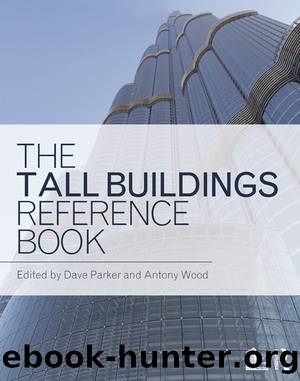The Tall Buildings Reference Book by Parker David Wood Antony

Author:Parker, David, Wood, Antony
Language: eng
Format: epub
Publisher: Taylor and Francis
17.4 The John Hancock Center, Chicago
Image: Skidmore, Owings & Merrill LLP/Ezra Stoller © Esto
A stiff shear system is necessary for the entire building to act as a single giant beam rather than an aggregation of individual elements or subsystems. Because it is not possible to create a completely rigid shear system, there exists a phenomenon called âshear lag.â This occurs when the overturning strains and stresses are not distributed linearly from the center of the tower, resulting in a less effective use of the towerâs vertical elements to resist the overturning moments on the structure. This is evident in Figure 17.2, where not all of the columns in the âflangesâ are uniformly stressed.
Although efficient and stiff shear resisting systems can reduce shear deformations to a small portion of the target deflections, it is not practical to do the same for the flexural deformations. The deflection of a steel I-beam without holes is almost totally attributable to the flexural bending. For a given layout, this deflection can generally only be reduced at the cost of increasing the size of the columns and/or walls. Beam deflection can be halved by doubling the area of the cross section, for example. The great expense of reducing deflections by increasing the cross-sectional area of the vertical element places very practical limits on reducing flexural deflections.
Download
This site does not store any files on its server. We only index and link to content provided by other sites. Please contact the content providers to delete copyright contents if any and email us, we'll remove relevant links or contents immediately.
| Automotive | Engineering |
| Transportation |
Whiskies Galore by Ian Buxton(41813)
Introduction to Aircraft Design (Cambridge Aerospace Series) by John P. Fielding(33049)
Small Unmanned Fixed-wing Aircraft Design by Andrew J. Keane Andras Sobester James P. Scanlan & András Sóbester & James P. Scanlan(32731)
Craft Beer for the Homebrewer by Michael Agnew(18124)
Turbulence by E. J. Noyes(7921)
The Complete Stick Figure Physics Tutorials by Allen Sarah(7291)
Kaplan MCAT General Chemistry Review by Kaplan(6852)
The Thirst by Nesbo Jo(6811)
Bad Blood by John Carreyrou(6525)
Modelling of Convective Heat and Mass Transfer in Rotating Flows by Igor V. Shevchuk(6378)
Learning SQL by Alan Beaulieu(6192)
Weapons of Math Destruction by Cathy O'Neil(6117)
Man-made Catastrophes and Risk Information Concealment by Dmitry Chernov & Didier Sornette(5904)
Digital Minimalism by Cal Newport;(5633)
Life 3.0: Being Human in the Age of Artificial Intelligence by Tegmark Max(5447)
iGen by Jean M. Twenge(5352)
Secrets of Antigravity Propulsion: Tesla, UFOs, and Classified Aerospace Technology by Ph.D. Paul A. Laviolette(5299)
Design of Trajectory Optimization Approach for Space Maneuver Vehicle Skip Entry Problems by Runqi Chai & Al Savvaris & Antonios Tsourdos & Senchun Chai(4996)
Electronic Devices & Circuits by Jacob Millman & Christos C. Halkias(4890)
